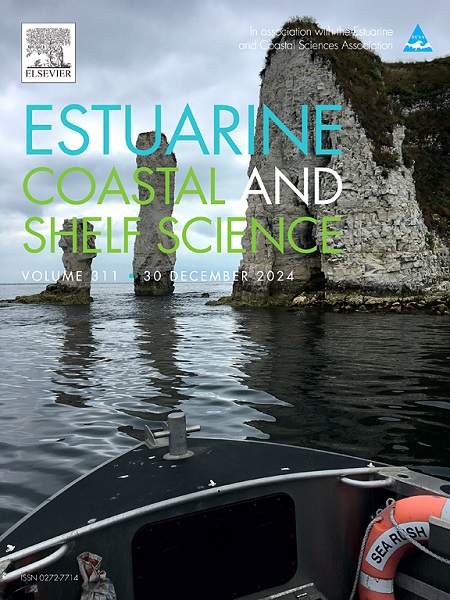上升流区的预估冷却和二氧化碳分压条件及其对著名岩岸生态系统工程师的影响
IF 2.6
3区 地球科学
Q1 MARINE & FRESHWATER BIOLOGY
引用次数: 0
摘要
到本世纪末,由于大气中温室气体的积累,预计上升流区将发生明显的变化。这些变化包括引起上升流的风的增强,海面温度的进一步降低(冷却),以及海洋酸化的加剧(OA)。虽然只有少数研究评估了这些系统中冷却条件的影响,但评估冷却和预估OA的综合影响的研究就更少了。本研究通过将潮间带紫色贻贝(Perumytilus purpuratus)的幼体暴露在不同的温度和二氧化碳浓度中来解决这一差距。采用中观系统和2 × 2因子设计,将紫色贻贝组暴露于当前(15°C)和预测冷却条件(10°C),以及当前和预测的pCO2水平(分别为500和1500 μatm)。两个月后,我们量化了贻贝的生长、钙化、足丝的产生、清除率和代谢率。生长、钙化和足丝产量始终受到温度以及温度与二氧化碳分压之间的相互作用的影响:在当前温度(15°C)下,所有这些变量都随着OA的增加而增加,但当暴露于预计的冷却条件(10°C)时,这些趋势逆转并随着OA的下降而下降。贻贝清除率遵循相同的趋势,但在这种情况下,唯一重要的因素是变量之间的相互作用。同时,代谢率随温度的升高而降低。对不同处理之间差异的仔细检查表明,主要变化始终与大多数响应变量对冷却和高二氧化碳分压条件组合的急剧下降有关。因此,预计本世纪末的变冷和OA可能对这种栖息地形成物种产生直接(负面)影响。间接地,这些压力因素的结合可能会削弱贻贝床的结构,降低栖息地的复杂性,从而停止提供给相关潮间带群落的利益。本文章由计算机程序翻译,如有差异,请以英文原文为准。
Projected cooling and pCO2 conditions in upwelling zones and their influence on a prominent rocky shore ecosystem engineer
By the end of the century, upwelling zones are expected to undergo distinct changes due to the accumulation of greenhouse gases in the atmosphere. These changes include an intensification of the winds causing upwelling, further reducing sea surface temperatures (cooling), and an intensification of ocean acidification (OA). While only a few studies have evaluated the influence of cooling conditions in these systems, even fewer have assessed the combined effects of cooling and projected OA. This study addressed this gap by exposing juveniles of the intertidal purple mussel (Perumytilus purpuratus), a prominent intertidal ecosystem engineer, to distinct temperatures and pCO2 levels. Using a mesocosm system and a 2 × 2 factorial design, groups of purple mussels were exposed to current (15 °C) and projected cooling conditions (10 °C), and current and projected pCO2 levels (500 and 1500 μatm, respectively). After two months, we quantified mussel growth, calcification, byssus thread production, clearance, and metabolic rates. Growth, calcification, and byssus thread production rates were consistently affected by temperature and by the interaction between temperature and pCO2: At current temperatures (15 °C) all these variables increased in response to OA, but when exposed to projected cooling conditions (10 °C), these trends reversed and declined with OA. Mussel clearance rates followed the same trend, but in this case the only significant factor was the interaction between variables. Meanwhile, metabolic rates declined with temperature. A close examination of the variation among treatments suggests that the main changes were consistently associated with a sharp decline in most response variables to a combination of cooling and high pCO2 conditions. Hence, projected end of the century cooling and OA are likely to have direct (negative) effects on this habitat-forming species. Indirectly, the combination of these stressors may weaken mussel bed structure and reduce habitat complexity, thereby halting the benefits provided to associated intertidal communities.
求助全文
通过发布文献求助,成功后即可免费获取论文全文。
去求助
来源期刊
CiteScore
5.60
自引率
7.10%
发文量
374
审稿时长
9 months
期刊介绍:
Estuarine, Coastal and Shelf Science is an international multidisciplinary journal devoted to the analysis of saline water phenomena ranging from the outer edge of the continental shelf to the upper limits of the tidal zone. The journal provides a unique forum, unifying the multidisciplinary approaches to the study of the oceanography of estuaries, coastal zones, and continental shelf seas. It features original research papers, review papers and short communications treating such disciplines as zoology, botany, geology, sedimentology, physical oceanography.

 求助内容:
求助内容: 应助结果提醒方式:
应助结果提醒方式:


